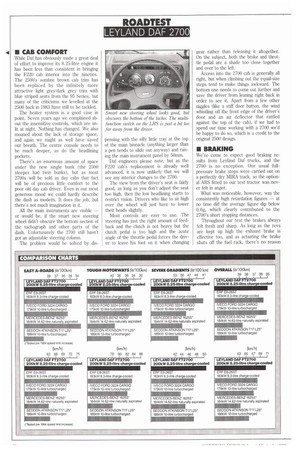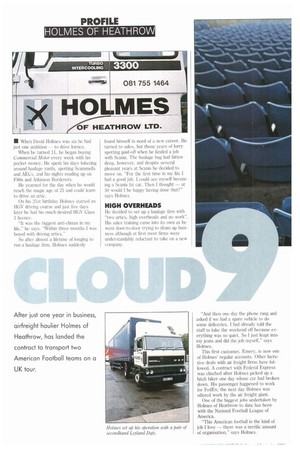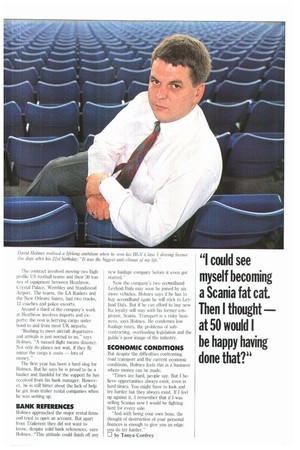ROADTEST LEYLAND DAF 2700
Page 30

Page 31

Page 32

Page 33

If you've noticed an error in this article please click here to report it so we can fix it.
While Daf has obviously made a great deal of effort to improve its 8.25-litre engine it has been less than consistent in bringing the F220 cab interior into the nineties. The 2500's sombre brown cab trim has been replaced by the infinitely more attractive light grey/dark grey trim with blue striped seats from the 95 Series, but many of the criticisms we levelled at the 2500 back in 1983 have still to be tackled.
The heater system is a good case in point. Seven years ago we complained about the insensitive controls, which are unlit at night. Nothing has changed. We also moaned about the lack of storage space, and again we might as well have saved our breath. The centre console needs to be much deeper, as do the headlining pockets.
There's an enormous amount of space under the new single bunk (the 2500 sleeper had twin bunks), but as most 2700s will be sold as day cabs that fact will be of precious little comfort to the poor old day cab driver. Even in our most generous mood we could hardly describe the dash as modern. It does the job, but there's not much imagination in it.
All the main instruments are visible — or would be, if the smart new steering wheel didn't obscure the bottom section of the tachograph and other parts of the dash. Unfortunately the 2700 still hasn't got an adjustable steering column.
The problem would be solved by dis pensing with the silly little tray at the top of the main binnacle (anything larger than a pen tends to slide out anyway) and raising the main instrument panel by 50mm.
Daf engineers please note, but as the F220 cab's replacement is already well advanced, it is now unlikely that we will see any interior changes to the 2700.
The view from the driver's seat is fairly good, as long as you don't adjust the seat too high, then the low headlining starts to restrict vision. Drivers who like to sit high over the wheel will just have to lower their heads slightly.
Most controls are easy to use. The steering has just the right amount of feedback and the clutch is not heavy but the clutch pedal is too high and the acute angle of the throttle pedal forces the driver to leave his foot on it when changing gear rather than releasing it altogether. On the subject, both the brake and throttle pedal are a shade too close together and over to the left.
Access into the 2700 cab is generally all right, but when climbing out the equal-size steps tend to make things awkward. The bottom one needs to come out further and save the driver from leaning right back in order to see it. Apart from a few other niggles (like a stiff door button, the wind whistling off the front edge of the driver's door and an air deflector that rattled against the top of the cab), if we had to spend our time working with a 2700 we'd be happy to do so, which is a credit to the original 2500 design.
• BRAKING
We've come to expect good braking results from Leyland Daf trucks, and the 2700 is no exception. Our usual fullpressure brake stops were carried out on a perfectly dry MIRA track, so the optional ABS fitted to our test tractor was never felt in anger.
What was noticeable, however, was the consistently high retardation figures — at no time did the average figure dip below 0.6g, which clearly contributed to the 2700's short stopping distances.
Throughout our test the brakes always felt fresh and sharp. As long as the revs are kept up high the exhaust brake is effective too, and as actuating the brake shuts off the fuel rack, there's no reason Old F220 cab has smart "Family 95" interior, but with a practical rubber floor covering for added fleet appeal. There's plenty of storage space under the bunk. . . if you buy the sleeper cab.
why a driver shouldn't take the engine revs up as high as 2,400rpm to get maximum back pressure.
• SERVICING
As the major revisions to the HS block are internal, not much has changed under the 2700 cab.
The new engine has gained two more glow plugs (making four in 'all) in the air intake, and these can now raise the intake air temperature from -18°C to 1.5°C in just five seconds. As a result Daf claims a 75% reduction in cold start fuel and much less smoke when starting up. New oil rings are also said to cut oil consumption.
Most daily checks are simply accomplished; the fuel pump is obscured by a noise suppression valance but this can be quickly removed.
• SUMMARY
We headlined our 1983 test of the 2500 "Frugal Flying Dutchman". For the 2700 read ditto, and then add some. The HS200 engine and Ecosplit have made a good truck into an even better one. A mainstream 32-tonne operator will find it a little cracker that manages to combine a distaste for dery with a strong appetite for hard work. It is also easy to drive and has a payload potential that few will sniff at.
Where the 2700 does start to come up against it is on price. For a truck that's basically been around for some time it's difficult to see how Leyland Daf can justify its 238,950 price tag, especially as its arch rival, the Cargo 3224C, comes in at 236,720 (although the more powerful day-cabbed 3828C with a 12-speed Twin Splitter is actually more expensive at 240,470).
The ERF, Volvo FL7, Mercedes-Benz 1726 and Seddon Atkinson 3-11 all undercut it at 238,260, 237,750, 237,500 and 237,802 respectively. Only the 205kW (275hp) Scania P93MA is significantly more expensive at 242,100, but then Scanias have seldom been cheap.
We could criticise the 2700 cab till we're blue in the face, but Daf is unlikely to change it now. What is important is that the negative aspects of the current model are not carried over to its replacement, which can't be far away. Once again, that means tackling the cab steps, instrumentation, storage, control layout and ride quality. In other words building a 32tonner for the nineties, and beyond.
If they can do that and still retain the 2700's excellent economy and performance, then Leyland Daf will have one hell of a tractor on its hands.
• When David Holmes was six he had just one ambition — to drive lorries.
When he turned 11, he began buying Commercial Motor every week with his pocket money. He spent his days loitering around haulage yards. spotting Scammells and AECs, and his nights reading up on F86s and Atkinson Borderers.
He yearned for the day when he would reach the magic age of 21 and could learn to drive an artic.
On his 21st birthday Holmes started an HGV driving course and just five days later he had his much-desired HGV Class 1 licence.
"It was the biggest anti-climax in my life," he says. "Within three months I was bored with driving artics."
So after almost a lifetime of longing to run a haulage firm, Holmes suddenly
found himself in need oi a new career. He turned to sales, but those years of lorry spotting paid-off when he landed a job with Scania. The haulage bug had bitten deep, however, and despite several pleasant years at Scania he decided to move on. "For the first time in my life I had a good job. I could see myself becoming a Scania fat cat. Then I thought — at 50 would I be happy having done that?" says Holmes.
HIGH OVERHEADS
He decided to set up a haulage firm with two artics, high overheads and no work". Ills sales training came into its own as he went door-to-door trying to drum up business although at first most firms were understandably reluctant to take on a new company.
"And then one day the phone rang and asked if we had a spare vehicle to do some deliveries. I had already told the staff to take the weekend off because everything was so quiet. So I just leapt into my jeans and did the job myself," says Holmes.
This first customer, Emery, is now one of Holmes' regular accounts. Other lucrative deals with air freight firms have followed. A contract with Federal Express was clinched after Holmes picked up a hitch hiker one day whose car had broken down. His passenger happened to work for FedEx; the next day Holmes was offered work by the air freight giant.
One of the biggest jobs undertaken by Holmes of Heathrow to date has been with the National Football League of America.
"This American football is the kind of job I love — there was a terrific amount of organisation," says Holmes. The contract involved moving two highprofile US football teams and their 30 tonnes of equipment between Heathrow, Crystal Palace, Wembley and Standstead Airport. The teams, the LA Raiders and the New Orleans Saints, had two trucks, 12 coaches and police escorts.
Around a third of the company's work at Heathrow involves imports and exports; the rest is ferrying cargo under bond to and from most UK airports.
"Rushing to meet aircraft departures and arrivals is just normal to us," says Holmes. "A missed flight means disaster. Not only do planes not wait, if they fly minus the cargo it costs — lots of money."
The first year has been a hard slog for Holmes. But he says he is proud to be a haulier and thankful for the support he has received from his bank manager. However, he is still bitter about the lack of help he got from trailer rental companies when he was setting up.
BANK REFERENCES
Holmes approached the major rental firms and tried to open an account. But apart from Trailerent they did not want to know, despite solid bank references, says Holmes. "This attitude could finish off any new haulage company before it even got started."
Now the company's two semndhand Leyland Dais may soon be joined by six more vehicles. Holmes says if he has to buy secondhand again he will stick to Leyland Uafs. But if he can afford to buy new his loyalty will stay with his former employer, Scania. Transport is a risky busk ness, says Holmes. He condemns low haulage rates, the problems of subcontracting, overloading legislation and the public's poor image of the industry.
ECONOMIC CONDITIONS
BLit despite the difficulties confronting road transport and the current economic conditions, Holmes feels this is a business where money can be made.
"Times are hard, people say. But I believe opportunities always exist, even in hard times. You might have to look and try harder but they always exist. III feel up against it, I remember that if I was selling Scanias now I would be fighting hard for every sale.
"And with being your own boss, the thought of destruction of your personal finances is enough to give you an edge. you do try harder."
U by Tanya Cordrey




































































